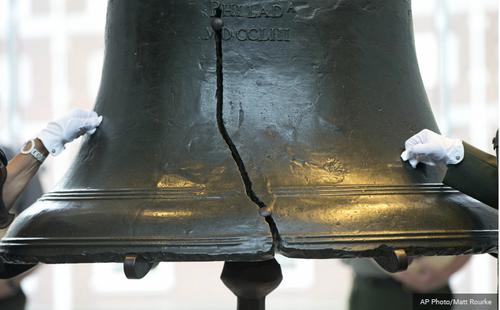
Authored by J. Peder Zane via RealClear Politics (emphasis ours),
Freedom is our Founding Fathers’ greatest gift.
Since 1776, that single word has been the compass and measure of the human experiment the world calls America. Whatever disparate, sometimes far-flung ideologies they may embrace, all who celebrate or bemoan our past, present, and future ground their claims and critiques in that single word. At heart, we are ever asking: How free are we? When you imagine all the other ideas those men in powdered wigs might have made our identity and obsession, freedom – which feels so hopeful, open-ended, and optimistic – seems the most salubrious of choices.
And yet, perhaps because the concept is so fundamental and familiar, we rarely ask a central question: What is freedom? We assume we truly know its meaning. But do we? Freedom has become like the operating systems that power our computers and the world – something the vast majority of us rely on, take for granted, without really understanding what it is and how it works. I believe that some, but not all, of our divisions are rooted in the lack of clear understanding of this guiding ideal.
In this short space, I want to describe a definition of freedom that is more accurate and hence more useful than the common understandings rooted in politics because it is based in the timeless laws of physics. This scientific lens, which is based on the work of Adrian Bejan, the celebrated professor of mechanical engineering at Duke University with whom I wrote the 2012 book “Design in Nature,” allows us to see freedom more fully and more accurately, in all its power and glory.
Start with the common understandings. The New Oxford American Dictionary defines freedom as “the power or right to act, speak, or think as one wants without hindrance or restraint.” Other meanings include “the state of not being imprisoned or enslaved,” and “the power of self-determination attributed to the will.”
Clear enough, so what’s the problem? These definitions offer a cramped and limited view of freedom, casting it as a human creation, as an idea that chiefly applies to the relations among people. Sure, we might say butterflies are free, that the time spent in the mountains – or even pants with an elastic waist – feel freeing, but those are metaphorical uses of a political concept. Ever since the ancient Greeks, freedom has concerned people.
Through hundreds of peer-reviewed papers and dozens of books, Bejan discovered that freedom is far more expansive. It is not a human concept but a physical reality.
The life of butterflies, and everything around us, hinges on freedom. He summarized this insight in a powerful statement he first articulated in 1995 and which he calls the constructal law. It states:
For a finite-size flow system to persist in time (to live), it must evolve with freedom in such a way that it provides easier access to the imposed currents that flow through it.
I know that’s a mouthful, but the idea is simple: Everything on our planet that moves – water on the ground, blood in our bodies, money through economies – constitutes a system composed of the current (water, blood, money) and channels they flow through (rivers, arteries, economies). Given the freedom to move and to change, these flow systems evolve with a specific direction in time, to move more current (or mass) more easily.
To see how, consider the first raindrops that fell to earth. In the beginning they were isolated entities. But soon they began to coalesce because it was easier to move or flow together. Over millions of years, these unthinking, inanimate molecules carved out rivulets, brooks, streams and rivers. Today, these tree-like river basins cover the globe, moving water from the plain to the ocean’s mouth far more efficiently than if the raindrops had been destined to seep by their lonesome.
Through his own extensive research and that of collaborators around the globe, Bejan has shown how the constructal law predicts the emergence and evolution of the designs that give shape and structure to our world. The same principle explains why air coalesces to form jet streams in the sky and why human history is the story of greater and easier movement of people, goods, money and ideas. All self-organize into better channels that allow them to flow more easily across the landscape.
Why does this happen? We don’t know. Like the laws of thermodynamics – which predict that hot should move to cold, that matter should be conserved – the constructal law is a first principle of physics that summarizes an observable and universal phenomenon: the tendency of matter to generate evolving designs that increase flow access. There is no mechanism behind it; it is an uncaused cause.
It all hinges on freedom: the freedom of flowing matter to generate evolving. It is the secret sauce of nature. Our planet evolved from a fiery molten ball into a wondrous sphere of oceans and rivers, mountains and forests, cities and air transport systems because of the freedom of everything that moves to generate designs that allow them to flow more easily. Bejan put it this way to me: “Freedom is many physical (measurable) features that allow an observed object to change. No freedom, no change. No change, no evolution. No evolution, no life. Freedom is physics—biological and nonbiological—and so is evolution, nature, and life.”
As I am writing for RealClearPolitics, the question remains: If freedom is not an exclusively human creation, how does physics change the way we should think about politics?
First, it shows us the limits of the common understanding of freedom as a fixed set of outcomes – as a chiseled-in-stone set of laws and practices against which human behavior must be measured. Don’t get me wrong, it is good to have ideals. But while they tell us where we might want to go, they do not tell us how to get there. This common understanding falsely assumes that ideas like freedom are simply things that we choose to embrace or reject. When we ask, for example, why democracy didn’t flourish in Russia after the fall of communism or in the Middle East during the Arab Spring, our answers revolve around the failings of leaders and the led.
The constructal law provides a better answer by showing that politics is anchored in physical realities – in the evolving systems through which ideas and laws, rights and practices move from the centers of power to the people and vice versa. In developed democracies such as the United States, the rule of law, the concepts of “one person one vote,” free and fair elections, and a free press are just a few of the “currents” that move through the designs of a democracy. These currents and channels cannot be simply imposed in one fell swoop; they must evolve, over time, building on what was, like the raindrops that gradually created the mighty river basins from the tiniest rivulets.
In assessing political systems, the central question is not, how free is it compared to some utopian ideal, but to what extent does it permit or restrict the freedom of people, ideas, goods, money, and all the rest to self-organize into designs that allow those things to move more easily?
Bejan, who grew up in Romania under communism, notes that dictatorships are doomed to failure because they are not just fighting the people, but physics. Censorship, coercion, and intimidation are the tools they use to constrain the tendency of everything in nature – which includes people – to flow more freely.
Finally, the physics of freedom should give us a new appreciation of the Founding Fathers. Their greatest gift to us was not the rights enshrined in the Declaration of Independence and the Constitution but a political system that was truly free – one that could evolve, get better. Those who see our past as a golden age are as misguided as those who view our history as a series of moral failures. America truly is a great experiment because our capacity for change means we never are, but are always becoming. In freedom.
Authored by J. Peder Zane via RealClear Politics (emphasis ours),
Freedom is our Founding Fathers’ greatest gift.
Since 1776, that single word has been the compass and measure of the human experiment the world calls America. Whatever disparate, sometimes far-flung ideologies they may embrace, all who celebrate or bemoan our past, present, and future ground their claims and critiques in that single word. At heart, we are ever asking: How free are we? When you imagine all the other ideas those men in powdered wigs might have made our identity and obsession, freedom – which feels so hopeful, open-ended, and optimistic – seems the most salubrious of choices.
And yet, perhaps because the concept is so fundamental and familiar, we rarely ask a central question: What is freedom? We assume we truly know its meaning. But do we? Freedom has become like the operating systems that power our computers and the world – something the vast majority of us rely on, take for granted, without really understanding what it is and how it works. I believe that some, but not all, of our divisions are rooted in the lack of clear understanding of this guiding ideal.
In this short space, I want to describe a definition of freedom that is more accurate and hence more useful than the common understandings rooted in politics because it is based in the timeless laws of physics. This scientific lens, which is based on the work of Adrian Bejan, the celebrated professor of mechanical engineering at Duke University with whom I wrote the 2012 book “Design in Nature,” allows us to see freedom more fully and more accurately, in all its power and glory.
Start with the common understandings. The New Oxford American Dictionary defines freedom as “the power or right to act, speak, or think as one wants without hindrance or restraint.” Other meanings include “the state of not being imprisoned or enslaved,” and “the power of self-determination attributed to the will.”
Clear enough, so what’s the problem? These definitions offer a cramped and limited view of freedom, casting it as a human creation, as an idea that chiefly applies to the relations among people. Sure, we might say butterflies are free, that the time spent in the mountains – or even pants with an elastic waist – feel freeing, but those are metaphorical uses of a political concept. Ever since the ancient Greeks, freedom has concerned people.
Through hundreds of peer-reviewed papers and dozens of books, Bejan discovered that freedom is far more expansive. It is not a human concept but a physical reality.
The life of butterflies, and everything around us, hinges on freedom. He summarized this insight in a powerful statement he first articulated in 1995 and which he calls the constructal law. It states:
For a finite-size flow system to persist in time (to live), it must evolve with freedom in such a way that it provides easier access to the imposed currents that flow through it.
I know that’s a mouthful, but the idea is simple: Everything on our planet that moves – water on the ground, blood in our bodies, money through economies – constitutes a system composed of the current (water, blood, money) and channels they flow through (rivers, arteries, economies). Given the freedom to move and to change, these flow systems evolve with a specific direction in time, to move more current (or mass) more easily.
To see how, consider the first raindrops that fell to earth. In the beginning they were isolated entities. But soon they began to coalesce because it was easier to move or flow together. Over millions of years, these unthinking, inanimate molecules carved out rivulets, brooks, streams and rivers. Today, these tree-like river basins cover the globe, moving water from the plain to the ocean’s mouth far more efficiently than if the raindrops had been destined to seep by their lonesome.
Through his own extensive research and that of collaborators around the globe, Bejan has shown how the constructal law predicts the emergence and evolution of the designs that give shape and structure to our world. The same principle explains why air coalesces to form jet streams in the sky and why human history is the story of greater and easier movement of people, goods, money and ideas. All self-organize into better channels that allow them to flow more easily across the landscape.
Why does this happen? We don’t know. Like the laws of thermodynamics – which predict that hot should move to cold, that matter should be conserved – the constructal law is a first principle of physics that summarizes an observable and universal phenomenon: the tendency of matter to generate evolving designs that increase flow access. There is no mechanism behind it; it is an uncaused cause.
It all hinges on freedom: the freedom of flowing matter to generate evolving. It is the secret sauce of nature. Our planet evolved from a fiery molten ball into a wondrous sphere of oceans and rivers, mountains and forests, cities and air transport systems because of the freedom of everything that moves to generate designs that allow them to flow more easily. Bejan put it this way to me: “Freedom is many physical (measurable) features that allow an observed object to change. No freedom, no change. No change, no evolution. No evolution, no life. Freedom is physics—biological and nonbiological—and so is evolution, nature, and life.”
As I am writing for RealClearPolitics, the question remains: If freedom is not an exclusively human creation, how does physics change the way we should think about politics?
First, it shows us the limits of the common understanding of freedom as a fixed set of outcomes – as a chiseled-in-stone set of laws and practices against which human behavior must be measured. Don’t get me wrong, it is good to have ideals. But while they tell us where we might want to go, they do not tell us how to get there. This common understanding falsely assumes that ideas like freedom are simply things that we choose to embrace or reject. When we ask, for example, why democracy didn’t flourish in Russia after the fall of communism or in the Middle East during the Arab Spring, our answers revolve around the failings of leaders and the led.
The constructal law provides a better answer by showing that politics is anchored in physical realities – in the evolving systems through which ideas and laws, rights and practices move from the centers of power to the people and vice versa. In developed democracies such as the United States, the rule of law, the concepts of “one person one vote,” free and fair elections, and a free press are just a few of the “currents” that move through the designs of a democracy. These currents and channels cannot be simply imposed in one fell swoop; they must evolve, over time, building on what was, like the raindrops that gradually created the mighty river basins from the tiniest rivulets.
In assessing political systems, the central question is not, how free is it compared to some utopian ideal, but to what extent does it permit or restrict the freedom of people, ideas, goods, money, and all the rest to self-organize into designs that allow those things to move more easily?
Bejan, who grew up in Romania under communism, notes that dictatorships are doomed to failure because they are not just fighting the people, but physics. Censorship, coercion, and intimidation are the tools they use to constrain the tendency of everything in nature – which includes people – to flow more freely.
Finally, the physics of freedom should give us a new appreciation of the Founding Fathers. Their greatest gift to us was not the rights enshrined in the Declaration of Independence and the Constitution but a political system that was truly free – one that could evolve, get better. Those who see our past as a golden age are as misguided as those who view our history as a series of moral failures. America truly is a great experiment because our capacity for change means we never are, but are always becoming. In freedom.





